Musselburgh and District Tramways
History
Powers for a tramway between the terminus of Edinburgh Corporation's Portobello cable-tram line at Joppa, and Levenhall, some three miles to the east, were granted on the 6th August 1900 under the Portobello and Musselburgh Tramways Order 1900; the order was confirmed under the umbrella of the Tramways Orders Confirmation (No. 3) Act, 1900. The promoter was the Drake and Gorham Electric Power and Traction Company, though by the time the act was signed into law, it had changed its name to the National Electric Traction Company Limited. The company was involved in several electric tramway schemes in the United Kingdom, but never actually operated a tramway itself, acquiring powers, then either selling them on or letting them lapse. Having acquired the requisite powers for the Musselburgh tramway, very little happened, presumably because the company either failed to find a buyer, or because it was unable or unwilling to raise the finance to build the tramway itself.
In 1902, a new application was made, this time by the Drake and Gorham Electric Power and Traction (Pioneer) Syndicate Limited, whose precise relationship to the NETCo is unclear, though it was possibly a subsidiary; the application sought powers to construct the section of tramway between Joppa and Brunstane Burn, i.e., within the City of Edinburgh. The new order seems to have been sought in order to change the conditions under which the company could build this section, though it also included an extension of the time allowed for construction of the original tramway. The powers were granted on the 11th August 1903 under the Portobello and Musselburgh Tramways Order 1903.
At some point after this, and prior to construction commencing, the tramway powers were acquired by the National Electric Construction Company, the D&GEP&T(P)SL presumably having sold them. The Musselburgh and District Tramways were to be the NECCo's first foray into tramway construction and operation, and it would go on to operate several tramways elsewhere in the country, namely: the City of Oxford Tramways (1907-1914), Dewsbury, Ossett & Soothill Nether Tramways (1908-1931), Mexborough & Swinton Tramways (1907-1929), Rhondda Tramways (1908-1934), and Torquay Tramways (1907-1934).
Construction of the standard-gauge, overhead electric system began around April 1904, the first electric services — between Joppa and Levenhall — commencing on the 12th December 1904; theses services were operated by just ten trams, though another four were added in the summer of 1905. The tramway was initially operated directly by the NECCo, but in August 1905, it handed the tramway over to a newly formed subsidiary, the Musselburgh and District Electric Light and Traction Company Limited.
The tramway was well patronised, and the company's thoughts soon turned to building an extension eastwards towards Tranent and Port Seton. With this in mind, the company tested the waters by introducing a motorbus service between Levenhall and Tranent in December 1905, and between Levenhall and Port Seton eight months later on the 11th August 1906.
Meanwhile, the company applied for powers to build an extension from Levenhall to Port Seton, these being granted on the 4th August 1906 under the Portobello and Musselburgh Tramways (Port Seton Extension) Order 1906. Unfortunately, building this was not straightforward, as the company had had to exclude the short section of the line within the municipality of Musselburgh (758 yards long) due to the objections of Musselburgh Town Council. These objections appear to have been an attempt by the council to extract significant concessions from the tramway company (e.g., road widening, and a percentage of takings), which the latter would not agree to. Although wiser heads eventually prevailed, a new act was required to build the missing section, powers for this being obtained on the 26th July 1907 under the Portobello and Musselburgh Tramways (Levenhall Extension) Order 1907.
The new extension was opened as far as Cockenzie on the 5th August 1909, and four months later to Port Seton, on the 3rd December. The fleet was expanded to sixteen cars to meet the increased need.
As with the majority of tramways in the British Isles, the system was badly affected by the Great War, primarily through loss of skilled men to the armed forces, but also restrictions on spares and new materials (e.g., rails). Like neighbouring Edinburgh, there was great concern locally about the increasing unreliability of the services, as well as the state of the tramcars. A measure of just how run down the tramway had become comes from an inspection of the tramcar fleet by Edinburgh Corporation in 1917, which found only one out of the sixteen tramcars to be in good condition. The situation was, however, gradually improved, the company managing to procure three secondhand vehicles from Sheffield Corporation Tramways in 1918.
Following the conversion of Edinburgh Corporation's cable-hauled Portobello line to overhead electric traction, through services were introduced between the company and the corporation systems on the 24th June 1923. The corporation operated services between Waterloo Place and Musselburgh Town Hall, whilst those between Waterloo Place and Port Seton were a joint company-corporation effort. Although the company replaced some of the worn-out tram track and doubled some sections of single track, it clearly did not have much confidence in the future of the line, given that there was no attempt at modernisation, expenditure being limited — in November 1923 — to another three secondhand cars from Sheffield Corporation Tramways.
The tramway had never been particularly profitable, but by 1927 it was suffering from severe competition from White Line motorbuses. Although both the company and the corporation made an attempt to combat the competition by cutting fares, this was only successful between Edinburgh and Levenhall, having little effect on the section beyond to Port Seton. The writing was now on the wall as far as tramway operation was concerned, and given the speed with which the tramway was now abandoned, it is likely that switching to motorbus operation had been in the company's mind for some time. The decision to withdraw the trams and replace them with motorbuses was probably taken in late 1927, in concert with the corporation, the latter ceasing to run beyond Levenhall from the 26th November 1927.
The company introduced motorbus services between Waterloo Place and Port Seton on the 23rd February 1928, the last company-operated tramway services ceasing two days later, though miners specials did apparently persist for another month or so at shift changeover times. On the 1st March 1928, the company reached agreement with the corporation for the latter to operate all tramcar services through to Levenhall, the company maintaining the track and providing the current.
The company now sought powers to abandon the tramway beyond Levenhall, something that it had effectively already done; the powers were granted under the Musselburgh and District Electric Tramways (Cessor of Powers) Order 1929, and the track was subsequently lifted.
In 1930, the company offered the remaining section of the tramway, as well as its Port Seton motorbus services, to the corporation; the latter had, however, to decline, as it did not have powers to operate motorbuses outside the city, and any attempt to acquire them would have met with significant objections from the main bus operator, Scottish Motor Traction. The corporation was nevertheless still keen to bring the line under its ownership, and on the 7th May 1931, it reached agreement with the company to buy it, the corporation taking over responsibility the following day, pending the acquisition of powers to purchase the tramway. The tramway passed into corporation ownership on the 25th April 1932 under the Edinburgh Corporation Order Confirmation Act 1932, by which time the NECCo and all its subsidiaries, including the M&DEL&TCo, was in the hands of the British Electric Traction Company, which had purchased the NECCo on 1st January 1932.
The last tramway services over the M&DT, which were operated by Edinburgh Corporation Transport between Joppa and Levenhall, ran on the 13th November 1954.
The M&DEL&TCo operated 6.62 miles of tramway, from the connection with the Edinburgh Corporation system at Joppa, eastwards to Port Seton, via Eastfield, Musselburgh, Levenhall, Prestonpans, and Cockenzie.
Uniforms
Motormen and conductors were issued with double-breasted, lancer-style tunics with five pairs of buttons (narrowing from top to bottom), and stand-up collars; the latter carried an employee number on the bearer's left-hand side (in individual metal numerals), and individual metal system initials — 'M E T' (standing for Musselburgh Electric Tramways) — on the bearer's right-hand side. The tensioned-crown peaked caps carried standard, off-the-shelf, script-lettering grade badges — either 'Motorman' or 'Conductor', seemingly worn on a coloured hat band. The badges and buttons were probably brass. Later on in the system's life — probably in 1923 — conductors were issued with single-breasted jackets with five buttons, two breast pockets, two waist pockets, and stand-up collars; the latter probably carried the same insignia as previously.
Tramcar crews were also provided with double-breasted greatcoats with high, fold-over collars; the bearer's right-hand collar usually bore 'M E T' system initials, though in later years both sides were often left plain.
Inspectors wore single-breasted jackets with hidden buttons — or more likely a hook and eye affair — a slit breast pocket and stand-up collars; the latter carried the grade — 'Inspector' — in embroidered script lettering. The jackets were edged in a finer material than the main body, with a chevron (in the same material) on the cuff of each sleeve. Caps were in the same style as those issued to tramcar staff, but carried the grade — 'Inspector' — in embroidered script lettering, very probably on a hat band. The chief inspector wore a virtually identical uniform to ordinary inspectors, but with— 'Chief Inspector' — on the jacket collars and the cap.
The M&DEL&TCo also employed the services of a traffic superintendent. This gentleman was issued with a double-breasted jacket with plain buttons and lapels; the collars bore the full grade — 'Traffic Superintendent' — in embroidered script lettering. His tensioned-crown peaked cap carried the grade — 'Traffic Superintendent' — in embroidered script lettering, very probably on a brocade hat band.
In common with the vast majority of tramway systems on the British mainland, women were employed during the Great War to replace men lost to the armed services, both as conductresses and as motorwomen, the first batch being appointed in 1915. A hand-coloured studio portrait (see below) shows that motorwomen, and probably conductresses too, were issued with single-breasted jackets with two breast pockets, high fold-over collars and epaulettes; both the breast pockets and the epaulettes had button closures, whilst the collars were plain. Although the photograph has been hand coloured, and may therefore have been subjected to a little artistic embellishment, it does seem to suggest that the edge of the jackets were piped in red, with a similar coloured strip adorning the epaulettes. Caps were baggy with a stiff glossy peak, so-called motor caps; they bore script-lettering grade badges, either 'Motorman' or 'Conductor'.
My grateful thanks go to Alan Brotchie for help with photographs and background information.
Further reading
For a history of Musselburgh's tramways, see: 'Edinburgh's Transport - Volume 1, The Early Years' by D L G Hunter; The Mercat Press (1992).
Images
Motormen and conductors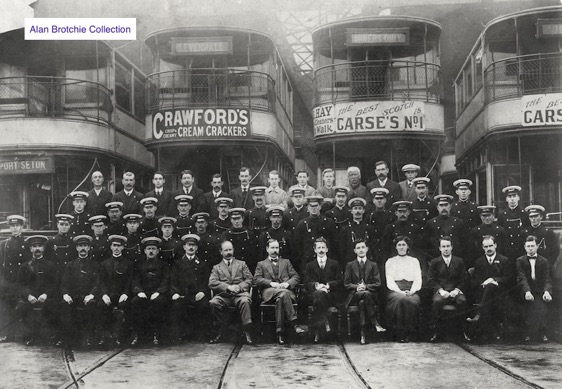
A staff photo, probably taken around 1912. Note the second tramcar from the right with 'Miners Only' in the indicator box, a reminder of two long-gone pits served by the tramway.
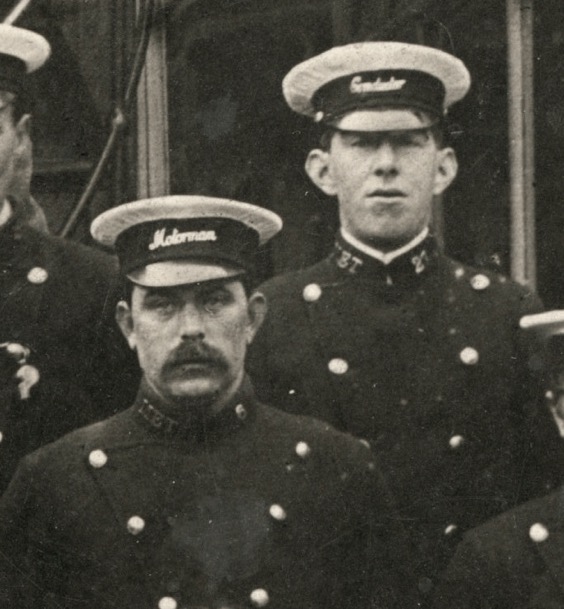
An enlargement of the above photograph showing a motorman and a conductor, both in lancer-style tunics. The collars clearly bear 'M E T' system initials on the bearer's right-hand side and an employee number on the left-hand side. Caps badges are standard, off-the-shelf script-lettering grade badges.
General pattern script-lettering cap badges of the type used by Musselburgh and District Tramways — brass. It is currently unclear whether the company used brass or nickel insignia.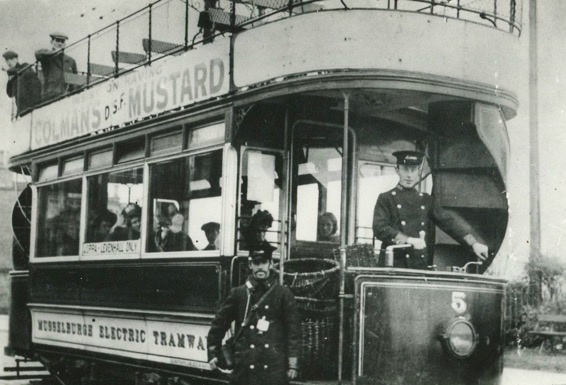
A conductor and a motorman pose for the cameraman with Tramcar No 5 on a Joppa-Levenhall service — photo undated, but probably taken between 1910 and 1915. Note the creels on the platform, almost certainly belonging to fishwives from Fisherrow, who usually had to travel on the rear platform due to objections from other passengers! Photo courtesy of the Stephen Howarth Collection.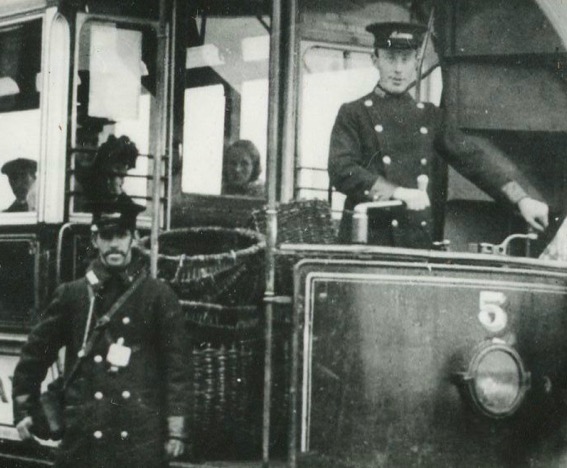
An enlargement of the above photograph showing the motorman and the conductor, the former in a double-breasted greatcoat and the latter in a double-breasted lancer-style tunic.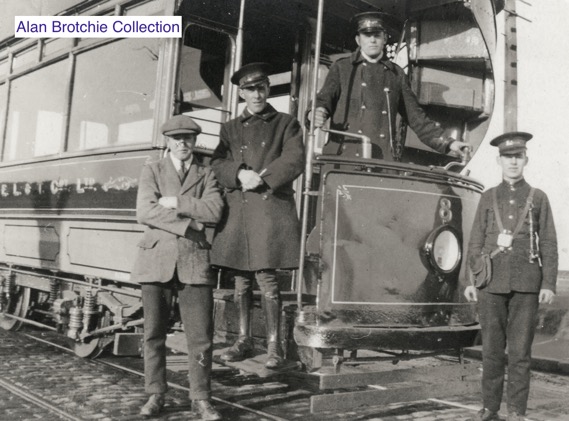
An inspector, a motorman and a conductor with Tramcar No 8. The car is in two shades of green livery with the title initials on the waist panel, dating the photo to after the 24 June 1923, when this livery was first applied to Musselburgh tramcars operating into Edinburgh Waterloo Place.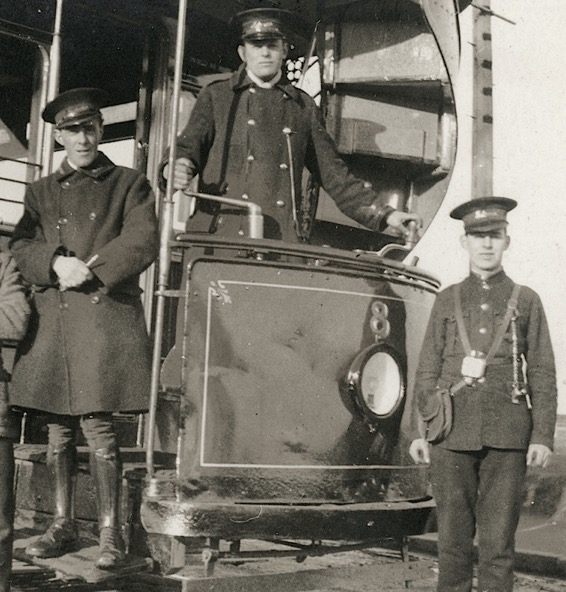
An enlargement of the above photograph showing the inspector, the motorman and the conductor. The latter is wearing a single-breasted jacket rather than the lancer-style tunics seen in earlier photos.
Senior staff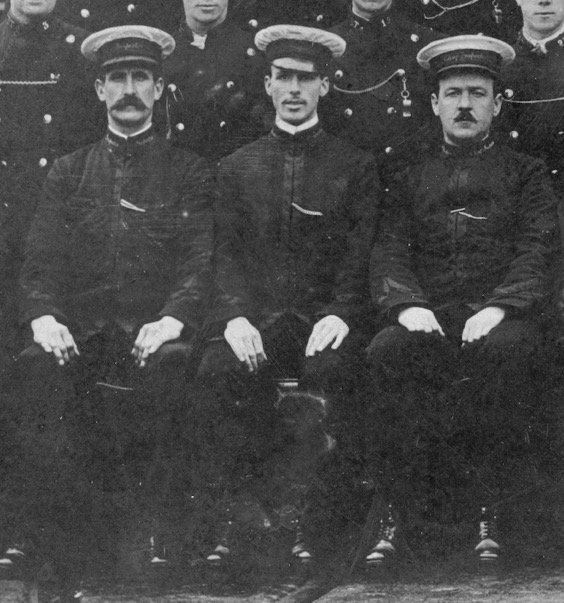
Two inspectors and a chief inspector (right), taken from the staff photograph above. All are wearing typical tramway inspector jackets with their grades embroidered on both the stand-up collars and the caps, and chevron embellishments on their sleeves. 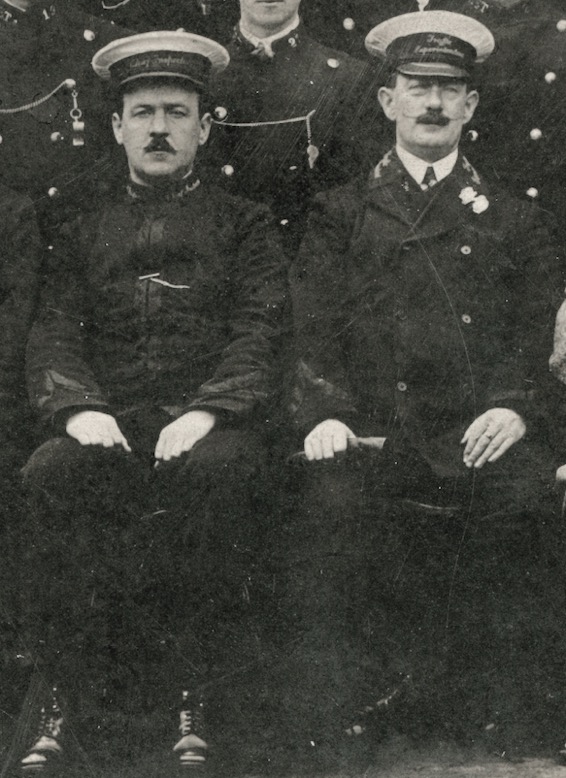
The chief inspector and the traffic superintendent. Whilst the former is wearing a uniform seemingly identical to those worn by inspectors (with the exception of the grade badges), the traffic superintendent is wearing a smart double-breasted jacket with lapels and unmarked buttons; his full grade is carried — in embroidered script lettering — on both of the jacket collars, as well as his cap.
Female staff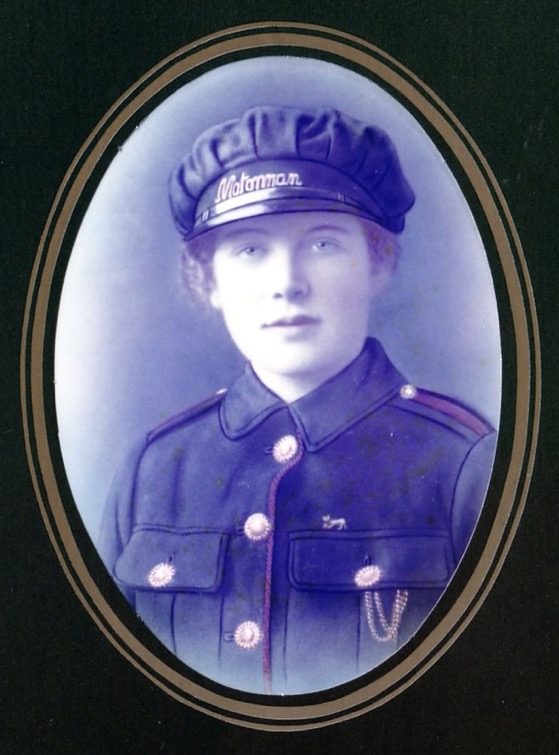
Musselburgh and District Tramways Great War motorwoman, Annie McGeechan — photo taken in 1917. Annie was born on 17th January 1898, married husband George Moffatt in 1920, and emigrated to New Zealand in 1927. Although the photo has been hand coloured, and may therefore have been subjected to a degree of artistic licence, the form of the buttons strongly suggests that they were plain with a scalloped rim (see link). Photo kindly provided by her grandson, Wayne Black.